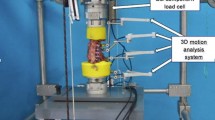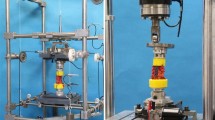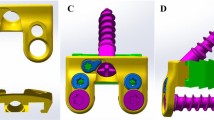Abstract
Introduction
A high rate of complications in multilevel cervical surgery with corpectomies and anterior-only screw-and-plate stabilization is reported. A 360°-instrumentation improves construct stiffness and fusion rates, but adds the morbidity of a second approach. A novel ATS-technique (technique that used anterior transpedicular screw placement) was recently described, yet no study to date has analyzed its performance after fatigue loading. Accordingly, the authors performed an analysis of construct stiffness after fatigue testing of a cervical 2-level corpectomy model reconstructed using a novel anterior transpedicular screw-and-plate technique (ATS-group) in comparison to standard antero-posterior instrumentation (360°-group).
Materials and methods
Twelve fresh-frozen human cervical spines were mounted on a spine motion tester to analyze restriction of ROM under loading (1.5 Nm) in flexion–extension (FE), axial rotation (AR), and lateral bending (LB). Testing was performed in the intact state, and after instrumentation of a 2-level corpectomy C4 + C5 using a cage and the constructs of ATS- and 360°-group, after 1,000 cycles, and after 2,000 cycles of fatigue testing. In the ATS-group (n = 6), instrumentation was achieved using a customized C3–C6 ATS-plate system. In the 360°-group (n = 6), instrumentation consisted of a standard anterior screw-and-plate system with a posterior instrumentation using C3–C6 lateral mass screws. Motion data were assessed as degrees and further processed as normalized values after standardization to the intact ROM state.
Results
Specimen age and BMD were not significantly different between the ATS- and 360°-groups. After instrumentation and 2,000 cycles of testing, no specimen exhibited a ROM greater than in the intact state. No specimen exhibited catastrophic construct failure after 2,000 cycles. Construct stiffness in the 360°-group was significantly increased compared to the ATS-group for all loading conditions, except for FE-testing after instrumentation. After 2,000 cycles, restriction of ROM under loading in FE was 39.8 ± 30 % in the ATS-group vs. 2.8 ± 2.3 % in the 360°-group, in AR 60.4 ± 25.8 vs 15 ± 11 %, and in LB 40 ± 23.4 vs 3.9 ± 1.2 %. Differences were significant (p < 0.05).
Conclusion
360°-instrumentation resembles the biomechanical standard of reference for stabilization of 2-level corpectomies. An ATS-construct was also shown to confer high construct stiffness, significantly reducing the percentage ROM beyond that of an intact specimen after 2,000 cycles. This type of instrumentation might be a clinical valuable and biomechanically sound adjunct to multilevel anterior surgical procedures.




Similar content being viewed by others
References
Sakaura H, Hosono N, Mukai Y, Ishii T, Iwasaki M, Yoshikawa H (2005) Long-term outcome of laminoplasty for cervical myelopathy due to disc herniation: a comparative study of laminoplasty and anterior spinal fusion. Spine 30:756–759
Acosta LF, Aryan HE, Chou D, Ames CP (2008) Long-term biomechanical stability and clinical improvement after extended multilevel corpectomy and circumferential reconstruction of the cervical spine using titanium mesh cages. J Spinal Disord Tech 21:165–174
Aryan HE, Sanchez-Mejia RO, Ben-Haim S, Ames CP (2007) Successful treatment of cervical myelopathy with minimal morbidity by circumferential decompression and fusion. Eur Spine J 16:1401–1409
Ratliff J, Cooper PR (2003) Cervical laminoplasty: a critical review. J Neurosurg (Spine) 98:230–238
Hart RA, Tatsumi RL, Hiratzka JR, Yoo JU (2008) Perioperative complications of combined anterior and posterior cervical decompression and fusion crossing the cervico-thoracic junction. Spine 33:2887–2891
Lu J, Wu X, Li Yonggang, Kong X (2007) Surgical results of anterior corpectomy in the aged patients with cervical myelopathy. Eur Spine J 17:129–135
O’Shaughnessy BA, Liu JC, Hsieh PC, Koski TR, Ganju A, Ondra SL (2008) Surgical treatment of fixed cervical kyphosis with myelopathy. Spine 33:771–778
Mummaneni PV, Dhall SS, Rodts GE, Haid RW (2008) Circumferential fusion for cervical kyphotic deformity. J Neurosurg Spine 9:515–521
Sakamoto T, Neo M, Nakamura T (2004) Transpedicular screw placement evaluated by axial computed tomography of the cervical pedicle. Spine 22:2510–2514
Steinmetz MP, Stewart TJ, Kager CD, Benzel EC, Vaccaro AR (2007) Cervical deformity correction. Neurosurg 60(Suppl):S90–S97
Koller H, Hempfing A, Ferraris L, Meier O, Metz-Stavenhagen P (2006) 4- and 5-level anterior fusions of the cervical spine: review of literature and clinical results. Eur Spine J 16:2055–2071
Brazenor GA (2007) Comparison of multisegment anterior cervical fixation using bone graft versus a titanium rod and buttress prosthesis. Spine 32:63–71
Liu Y, Qi M, Chen H, Yang L, Wang X, Shi G, Gao R, Wang C, Yuan W (2012) Comparative analysis of complications of different reconstructive techniques following anterior decompression for multilevel cervical spondylotic myelopathy. Eur Spine J 21:2428–2435
Sembrano JN, Mehbod AA, Garvey TA, Denis F, Perra JH, Schwender JD, Transfeldt EE, Winter RB, Wroblewski M (2009) A concomitant posterior approach improves fusion rates but not overall reoperation rates in multilevel cervical fusion for spondylosis. J Spinal Disord Tech 22:162–169
Koller H, Hempfing A, Acosta F, Fox M, Scheiter A, Tauber M, Holz U, Resch H, Hitzl W (2008) Cervical anterior transpedicular screw fixation. Part I: study on morphological feasibility, indications, and technical prerequisites. Eur Spine J 17:523–538
Schlenk RP, Kowalski RJ, Benzel EC (2003) Biomechanics of spinal deformity. Neurosurg Focus 14:Article 2
Bogduk N, Mercer S (2000) Biomechanics of the cervical spine. I: Normal kinematics. Clin Biomech 15:633–648
Setzer M, Eleraky M, Johnson WM, Aghayev K, Tran ND, Vrions FD (2012) Biomechanical comparison of anterior cervical spine instrumentation techniques with and without supplemental posterior fusion after different corpectomy and discectomy combinations. J Neurosurg Spine 16:579–584
A N, Hussain M, Natarajan RN, An HS, Gunnar BJ, Andersson GB (2011) Biomechanical effects of anterior, posterior, and combined anterior-posterior instrumentation techniques on the stability of a multilevel cervical corpectomy construct: a finite element model analysis. Spine J 11:324–330
Shamji MF, Cook C, Pietrobon R, Tackett S, Brown C, Isaacs RE (2008) Impact of surgical approach on complications and resource utilization of cervical spine fusion: a nationwide perspective to the surgical treatment of diffuse cervical spondylosis. Spine J 9:10–16
Yukawa Y, Kato F, Ito K, Nakashima H, Machino M (2009) Anterior cervical pedicle screw and plate fixation using fluoroscope-assisted pedicle axis view imaging: a preliminary report of a new cervical reconstruction technique. Eur Spine J 18:911–916
Aramomi M, Masaki Y, Koshizuka, Kadota R, Okawa A, Koda M, Yamazaki M (2008) Anterior pedicle screw fixation for multilevel cervical corpectomy and spinal fusion. Acta Neurochir 150:575–582
Koller H, Acosta F, Tauber M, Fox M, Martin H, Forstner R, Augat P, Penzkofer R, Pirich C, Kässmann H, Resch H, Hitzl W (2008) Cervical anterior transpedicular screw fixation (ATPS)—Part II. Accuracy of manual insertion and pull-out strength of ATPS. Eur Spine J 17:539–555
Ikenaga M, Mukaida M, Nagahara R, Yasunaga T, Ueda Y, Sohma Y (2012) Anterior cervical reconstruction with pedicle screws after a 4-level corpectomy. Spine 37:E927–E930
Wei-hu Ma, Yu L, Song X-H, Xu R-M, Hu Y, Zhao L-J, Sun S-H, Jiang W-Y, Gu Y-J (2013) Anterior transpedicular screw fixation technique for failed anterior cervical internal fixation in revision surgery: a Case report. Orthoped Surg 5:305–308
Kothe R, Rüter W, Schneider E, Linke B (2004) Biomechanical analysis of transpedicular screw fixation in the subaxial cervical spine. Spine 29:1869–1875
Panjabi MM, Isomi T, Wang JL (1999) Loosening at the screw-vertebra junction in multilevel anterior cervical plate constructs. Spine 24:2383–2388
Wilke HJ, Wenger K, Claes L (1998) Testing criteria for spinal implants: recommendations for the standardization of in vitro stability testing of spinal implants. Eur Spine J 7:148–154
Wilke HJ, Jungkunz B, Wenger K, Claes LE (1998) Spinal segment range of motion as a function of in vitro test conditions: effects of exposure period, accumulated cycles, angular- deformation rate, and moisture condition. Anat Rec 251:15–19
Disch AC, Schaser KD, Melcher I, Luzzati A (2008) En bloc spondylectomy reconstructions in a biomechanical in vitro study. Eur Spine J 17:715–725
Blinded for review (2012) Biomechanical evaluation of a posterior non-fusion instrumentation of the lumbar spine. Eur Spine J 21:939–945
Blinded for review (2010) Vertebroplasty with self-locking hexagonal metal implants shows comparable primary and secondary stiffness to PMMA cement augmentation techniques in a biomechanical vertebral compression fracture model. Eur Spine J 19:1029–1036
Blinded for review (2009) Non-fusion instrumentation of the lumbar spine with a hinged pedicle screw rod system: an in vitro experiment. Eur Spine J 18:1478–1485
Singh K, Vaccaro AR, Kim J, Lorenz EP, Lim TH, An HS (2004) Enhancement of stability following anterior cervical corpectomy: a biomechanical study. Spine 29:845–849
Dmitriev AE, Kuklo TR, Lehman RA Jr, Rosner MK (2007) Stabilizing potential of anterior, posterior, and circumferential fixation for multilevel cervical arthrodesis. Spine 32:E188–E196
Wilke HJ, Mehnert U, Claes LE, Bierschneider MM, Jaksche H, Boszczyk BM (2006) Biomechanical evaluation of vertebroplasty and kyphoplasty with polymethyl methacrylate or calcium phosphate cement under cyclic loading. Spine 31:2934–2941
Chen C, Ruan D, Wu C, Wu W, Sun P, Zhang Y, Wu J, Lu S, Ouyang Z (2013) CT morphometric analysis to determine the anatomical basis for the use of transpedicular screws during reconstruction and fixations of anterior cervical vertebrae. PLoS One 8:E81159
Fu M, Lin L, Kong X, Zhao W, Tang L, Li J, Ouyang (2013) Construction and accuracy assessment of patient specific biocompatible drill template for cervical anterior transpedicular screw (ATPS) insertion: an In vitro study. PLoS One 8:E53580
Johnston LT, Karaikovic EE, Lautenschlager EP, Marcu D (2006) Cervical pedicle screws vs. lateral mass screws: uniplanar fatigue analysis and residual pullout strengths. Spine J 6:667–672
Jones EL, Heller JG, Silcox DH, Hutton WC (1997) Cervical pedicle screws versus lateral mass screws: anatomic feasibility and biomechanical comparison. Spine 22:977–982
Koller H, Schmidt R, Mayer M, Hitzl W, Zenner J, Midderhoff S, Graf N, Resch H, Wilke HJ (2010) The stabilizing potential of anterior, posterior and combined techniques for the reconstruction of a 2-level cervical corpectomy model: biomechanical study and first results of ATPS prototyping. Eur Spine J 19:2137–2148
Zhang H, Bai J (2007) Development and validation of a finite element model of the occipito-atlantoaxial complex under physiologic loads. Spine 2007:968–974
Puttlitz CM, Goel VK, Clark CR, Traynelis VC, Scifert JL, Grosland NM (2000) Biomechanical rationale for the pathology of rheumatoid arthritis in the craniovertebral junction. Spine 25:1607–1616
Fogel GR, Li Z, Liu W, Liao Z, Wu J, Zhou W (2010) In vitro evaluation of stiffness and load sharing in a two-level corpectomy: comparison of static and dynamic cervical plates. Spine J 10:417–421
DiAngelo DJ, Foley KT, Vossel KA, Rampersaud YR, Jansen TH (2000) Anterior cervical plating reverses load transfer in multilevel strut graft. Spine 25:2366–2376
Isomi T, Panjabi MM, Wang JL, Vaccaro AR, Garfin SR, Patel T (1999) Stabilizing potential of anterior cervical plates in multilevel corpectomies. Spine 24:2219–2223
Hussain M, Nassr A, Natarajan RN, An HS, Andersson GB (2013) Biomechanics of adjacent segments after a multilevel cervical corpectomy using anterior, posterior, and combined anterior-posterior instrumentation techniques: a finite element model study. Spine J 13:689–696
Hussain M, Natarajan RN, Fayyazi AH, Braaksma BR, Anderson GBJ, An HS (2009) Screw angulation affects bone-screw stresses and bone graft load sharing in anterior cervical corpectomy fusion with a rigid screw plate construct: a finite element model study. Spine J 9:1016–1023
Schlenk RP, Stewart T, Benzel EC (2003) The biomechanics of iatrogenic spinal destabilization and implant failure. Neurosurg Focus 15 (3):Article 2
Conflict of interest
None.
Author information
Authors and Affiliations
Corresponding author
Rights and permissions
About this article
Cite this article
Koller, H., Schmoelz, W., Zenner, J. et al. Construct stability of an instrumented 2-level cervical corpectomy model following fatigue testing: biomechanical comparison of circumferential antero-posterior instrumentation versus a novel anterior-only transpedicular screw–plate fixation technique. Eur Spine J 24, 2848–2856 (2015). https://doi.org/10.1007/s00586-015-3770-z
Received:
Revised:
Accepted:
Published:
Issue Date:
DOI: https://doi.org/10.1007/s00586-015-3770-z




